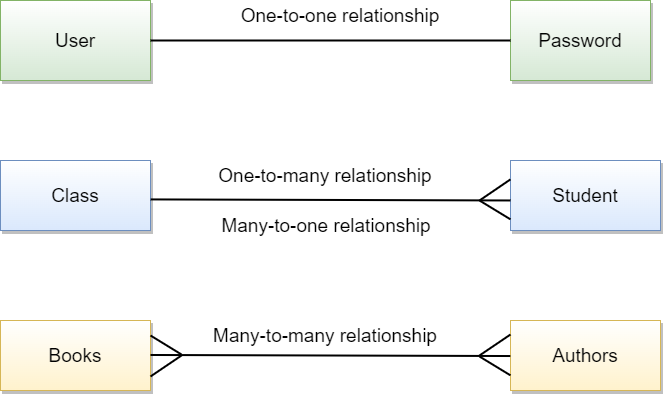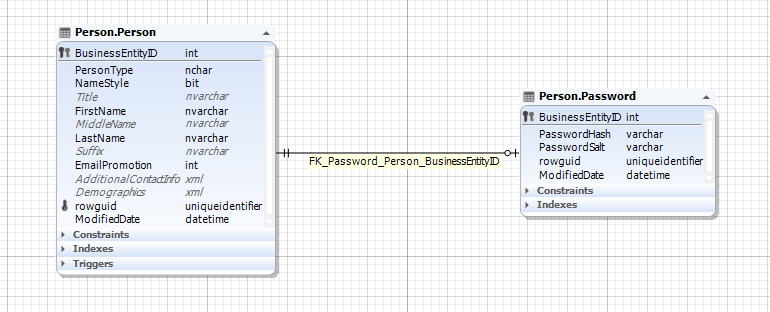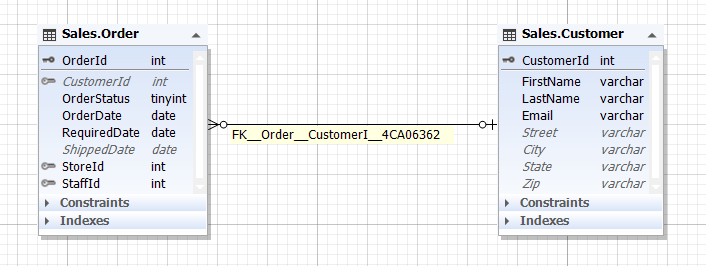Entity Framework Core (EF Core) is a modern object-relational mapper (ORM) for .NET Core and .NET applications, enabling efficient database interaction while minimizing the need for raw SQL queries. A fundamental aspect of EF Core is defining Entity Framework relationships, ensuring data consistency and referential integrity in relational databases.
This guide explores one-to-one, one-to-many, and many-to-many relationships in EF Core, covering their implementation, configuration, and best practices. Additionally, we will introduce Entity Developer, a powerful ORM modeling tool which simplifies relationship management, code generation, and schema synchronization for EF Core applications.
By the end of this article, you’ll have a clear understanding of how to structure EF Core entity relationships effectively and leverage tools to optimize database design and management in EF Core.
- Understanding Entity Relationships in EF Core
- One-to-One Relationships in EF Core
- Many-to-One Relationships in EF Core
- Many-to-Many Relationships in EF Core
- Advanced Relationship Management in EF Core
- Tools for Simplifying ORM Work in EF Core
- Conclusion
Understanding Entity Relationships in EF Core
In terms of database design, entity relationships define how tables are connected. They are all about ensuring that the data remains consistent at all times and query execution always stays efficient. Entity Framework Core relationships are established with the help of navigation properties and foreign keys, which facilitates seamless class-based access to relational data.
EF Core supports such main relationship types as:
- One-to-One (1:1) – Each item in one table connects to only one item in another table. This link is created using a foreign key and an EF Core navigation property.
- One-to-Many (1:N) – One item in a table can be linked to multiple items in another table. The connection is made using a foreign key in the related (dependent) table.
- Many-to-One (N:1) – The inverse of EF Core One-to-Many, where multiple items in one table connect to a single item in another table.
- Many-to-Many (N:N) – Multiple items in a single table can be linked to multiple ones in another table. A junction table that contains foreign keys is used to store these connections.

Defining relationships with foreign keys and navigation properties is what allows EF Core to manage relational data in a productive way while making queries less complex.
One-to-One Relationships in EF Core
An EF Core One-to-One (1:1) relationship occurs when one entity is linked to exactly one related entity. For example, a User may have a UserProfile, where each user corresponds to a single profile.
When to Use EF Core Relationships One-to-One?
- Separating concerns (e.g., storing sensitive user details separately).
- Optimizing performance (e.g., moving rarely accessed data to another table).

Configuring Entity Framework Core One-to-One Relationships
1. By Convention: EF Core automatically detects one-to-one relationships, for which a navigation property needs to be present in both entities.
public class User
{
public int UserId { get; set; }
public string Username { get; set; }
// Navigation property
public UserProfile UserProfile { get; set; }
}
public class UserProfile
{
public int UserProfileId { get; set; }
public string Bio { get; set; }
// Navigation property
public User User { get; set; }
}In this example:
Userhas a primary keyUserId.UserProfilehas a primary keyUserProfileId.UserProfilehas a navigation propertyUser, and EF Core will look for a foreign key property namedUserIdby convention.
2. Using Data Annotations:
public class User
{
[Key]
public int UserId { get; set; }
public string Username { get; set; }
// Navigation property
public UserProfile UserProfile { get; set; }
}
public class UserProfile
{
[Key]
[ForeignKey("User")]
public int UserProfileId { get; set; }
public string Bio { get; set; }
// Navigation property
public User User { get; set; }
}In this example:
Userhas a navigation propertyUserProfileto access the relatedUserProfileentity.UserProfilehas a navigation propertyUserto access the relatedUserentity.
3. DbContext with Fluent API Configuration:
using Microsoft.EntityFrameworkCore;
public class ApplicationDbContext : DbContext
{
public DbSet<User> Users { get; set; }
public DbSet<UserProfile> UserProfiles { get; set; }
protected override void OnModelCreating(ModelBuilder modelBuilder)
{
modelBuilder.Entity<User>()
.HasOne(u => u.UserProfile)
.WithOne(up => up.User)
.HasForeignKey<UserProfile>(up => up.UserProfileId);
}
}In this example:
- HasOne: Specifies that a
Userhas oneUserProfile. - WithOne: Specifies that a
UserProfileis associated with oneUser. - HasForeignKey: Specifies that
UserProfileIdinUserProfileis the foreign key that establishes the relationship withUser.
Usage of EF Core One-to-One Relationships
using (var context = new ApplicationDbContext())
{
var user = new User
{
Username = "johndoe",
UserProfile = new UserProfile
{
Bio = "Software Developer"
}
};
context.Users.Add(user);
context.SaveChanges();
}Many-to-One Relationships in EF Core
A Many-to-One (N:1) relationship is the inverse of an Entity Framework One-to-Many, where multiple entities reference a single parent entity. For instance, in an e-commerce system, multiple Orders belong to a single Customer, but each order is linked to only one customer. In EF Core relationships One-to-Many, such associations model cases where one entity links to multiple dependents.

Configuring Many-to-One Relationships in EF Core
1. By Convention: EF Core automatically detects many-to-one relationships when an entity has a foreign key reference to another entity.
public class Author
{
public int AuthorId { get; set; }
public string Name { get; set; }
// Navigation property
public List<Book> Books { get; set; }
}
public class Book
{
public int BookId { get; set; }
public string Title { get; set; }
// Foreign key property
public int AuthorId { get; set; }
// Navigation property
public Author Author { get; set; }
}In this example:
Authorhas a collection navigation propertyBooksto access relatedBookentities.Bookhas a reference navigation propertyAuthorto access the relatedAuthorentity.
2. Using Data Annotations:
public class Author
{
[Key]
public int AuthorId { get; set; }
public string Name { get; set; }
// Navigation property
public List<Book> Books { get; set; }
}
public class Book
{
[Key]
public int BookId { get; set; }
public string Title { get; set; }
// Foreign key property
[ForeignKey("Author")]
public int AuthorId { get; set; }
// Navigation property
public Author Author { get; set; }
}In this example:
Authorhas a collection navigation propertyBooksto access relatedBookentities.Bookhas a reference navigation propertyAuthorto access the relatedAuthorentity.
3. DbContext with Fluent API Configuration:
using Microsoft.EntityFrameworkCore;
public class ApplicationDbContext : DbContext
{
public DbSet<Author> Authors { get; set; }
public DbSet<Book> Books { get; set; }
protected override void OnModelCreating(ModelBuilder modelBuilder)
{
modelBuilder.Entity<Book>()
.HasOne(b => b.Author)
.WithMany(a => a.Books)
.HasForeignKey(b => b.AuthorId);
}
}In this example:
- HasOne: Specifies that a
Bookhas oneAuthor. - WithMany: Specifies that an
Authorcan have manyBooks. - HasForeignKey: Specifies that
AuthorIdinBookis the foreign key that establishes the relationship withAuthor.
Usage of EF Core Many-to-One Relationships
using (var context = new ApplicationDbContext())
{
var author = new Author
{
Name = "George Orwell",
Books = new List<Book>
{
new Book { Title = "1984" },
new Book { Title = "Animal Farm" }
}
};
context.Authors.Add(author);
context.SaveChanges();
}Many-to-Many Relationships in EF Core
An Entity Framework Core Many-to-Many (N:N) relationship occurs when multiple entities are associated with multiple related entities. For example, Students can enroll in multiple Courses, and each course can have multiple students. Similarly, Products can belong to multiple Categories, and categories can contain multiple products.

Configuring EF Core Relationships Many-to-Many
1. Using a Join Table (Before EF Core 5.0): Before EF Core 5.0, a junction entity was required to model many-to-many relationships explicitly.
public class Student
{
public int StudentId { get; set; }
public string Name { get; set; }
// Navigation property
public List<Course> Courses { get; set; }
}
public class Course
{
public int CourseId { get; set; }
public string CourseName { get; set; }
// Navigation property
public List<Student> Students { get; set; }
}
public class StudentCourse
{
public int StudentId { get; set; }
public Student Student { get; set; }
public int CourseId { get; set; }
public Course Course { get; set; }
}Explanation
- Join Table: The
StudentCourseentity serves as the join table, containing foreign keys to bothStudentandCourse. - Composite Key: The
HasKeymethod specifies that the combination ofStudentIdandCourseIdserves as the composite primary key for the join table. - Relationships:
HasOneandWithManymethods define the relationships betweenStudentCourseand the respective entities (StudentandCourse).HasForeignKeyspecifies the foreign key properties in the join table.
2. Using Implicit Many-to-Many Support (EF Core 5.0+): EF Core automatically creates a join table when defining many-to-many relationships with navigation properties.
public class Student
{
public int StudentId { get; set; }
public string Name { get; set; }
// Navigation property
public List<Course> Courses { get; set; }
}
public class Course
{
public int CourseId { get; set; }
public string CourseName { get; set; }
// Navigation property
public List<Student> Students { get; set; }
}Explanation
- Navigation Properties: Both
StudentandCourseentities have navigation properties that are collections of the other entity type. - Implicit Join Table: EF Core will automatically create a join table named
StudentCourse(by default) with foreign keys to bothStudentandCourse. - Fluent API Configuration: The
HasManyandWithManymethods in theOnModelCreatingmethod are used to configure the many-to-many relationship.
Usage of EF Core Many-to-Many Relationships
You can use these entities to perform database operations as follows:
using (var context = new SchoolDbContext())
{
var student = new Student
{
Name = "Alice",
Courses = new List<Course>
{
new Course { CourseName = "Mathematics" },
new Course { CourseName = "Physics" }
}
};
context.Students.Add(student);
context.SaveChanges();
}Advanced Relationship Management in EF Core
Managing Referential Integrity and Cascade Delete
Entity Framework foreign keys enforce referential integrity, ensuring that related records remain consistent. When deleting a parent entity, cascade delete rules determine whether dependent entities are also removed. This is crucial when restructuring relationships or migrating data.
EF Core supports three behaviors:
- Cascade: Deletes dependent entities automatically.
- Restrict: Prevents deletion if related entities exist.
- SetNull: Replaces foreign key values with NULL instead of removing the record.
Here’s how you can configure cascade delete with the help of Fluent API:
using Microsoft.EntityFrameworkCore;
public class LibraryDbContext : DbContext
{
public DbSet<Author> Authors { get; set; }
public DbSet<Book> Books { get; set; }
protected override void OnModelCreating(ModelBuilder modelBuilder)
{
modelBuilder.Entity<Book>()
.HasOne(b => b.Author)
.WithMany(a => a.Books)
.HasForeignKey(b => b.AuthorId)
.OnDelete(DeleteBehavior.Cascade);
}
}When you manage cascade delete in a proper way, this prevents orphaned records, maintaining the consistency of data.
Compare EF Core with other .NET ORM frameworks to learn which one will suit you better.
Tools for Simplifying ORM Work in EF Core
Developers working with EF Core, NHibernate, and LinqConnect often need a visual tool to manage entity relationships efficiently. Entity Developer simplifies ORM design by allowing developers to define relationships visually instead of manually coding them. Additionally, dotConnect enhances database connectivity, providing high-performance integration for EF Core and other ORMs.
How Entity Developer Helps Manage EF Core Relationships
Entity Developer allows programmers to graphically define One-to-One, One-to-Many, Many-to-One, and Many-to-Many relationships, eliminating the need for manual configuration in code. It automatically generates the EF Core model based on the visual schema, reducing errors and improving development speed across an entire project.

.NET and C# programmers benefit from Entity Developer by optimizing ORM mapping, ensuring consistent data models, and reducing time spent on debugging relationship configurations. With its intuitive interface, it’s an essential tool for handling complex database schemas efficiently.
Download a free trial of Entity Developer to simplify EF Core relationship management.
dotConnect – A Universal Connector for EF Core and Other ORMs
dotConnect is a high-performance ADO.NET provider. What it does is enable EF Core applications to connect to PostgreSQL, MySQL, SQLite, Oracle, and more. dotConnect does not alter EF Core relationships, but it works well for enhancing database connectivity and query execution while boosting general application stability.
With built-in optimizations for EF Core, NHibernate, and LinqConnect, dotConnect improves data access speed and reduces latency. If you are a developer needing database communication that runs smoothly across multiple ORM frameworks, this is your reliable solution.
Try dotConnect for free: it’s the simplest way to experience fully optimized database connectivity for EF Core applications.
Conclusion
If your goal is to design efficient database schemas, you cannot do so without understanding One-to-One, One-to-Many, and Many-to-Many relationships in EF Core. When you properly configure relationships using conventions, Data Annotations, and Fluent API, this leads to increased data integrity, upscale performance, and maintainable code.
Entity Developer’s visual approach to relationship management works well to simplify ORM processes, while dotConnect is the go-to solution for enhancing database connectivity and query execution.
When developers apply best practices in EF Core, coupled with leveraging advanced ORM tools, they can build applications that are scalable and high-performance.
Boost your EF Core database connectivity by getting started with dotConnect today.


